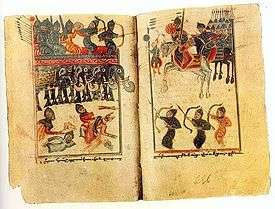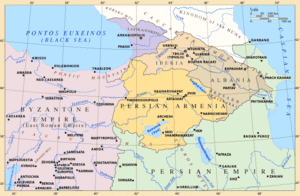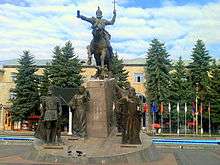Battle of Avarayr
Coordinates: 39°20′19.65″N 45°3′25.53″E / 39.3387917°N 45.0570917°E
| Battle of Avarayr | |||||||
|---|---|---|---|---|---|---|---|
 A 15th century Armenian miniature depicting the battle | |||||||
| |||||||
| Belligerents | |||||||
|
Sassanid Empire Pro-Sassanid Armenians | Christian Armenian rebels | ||||||
| Commanders and leaders | |||||||
|
Mushkin Niusalavurd Mihr Narseh Izad Gushnasp Ashtat |
Vartan Mamikonian † Ghevond Vanandetsi[5] | ||||||
| Strength | |||||||
|
+300,000 Total Military Units; 200,000 Sassanids[6] Unknown number of Persian Madyan and elephants 60,000[7]-20,000 pro-Sassanid Armenians | 66,000 Armenian rebels[8] | ||||||
| Casualties and losses | |||||||
| Very Heavy [9] | Heavy | ||||||
The Battle of Avarayr (Armenian: Ավարայրի ճակատամարտ Avarayri čakatamart) was fought on 26 May 451 AD on the Avarayr Plain in Vaspurakan, between the Armenian Army under Vardan Mamikonian and Sassanid Persia. It was one of the first battles in defence of the Christian faith in history. Although the Persians were victorious on the battlefield itself, the battle proved to be a major strategic victory for Armenians, as Avarayr paved the way to the Nvarsak Treaty (484 AD), which affirmed Armenia's right to practice Christianity freely.[2][3]
The battle is widely seen as one of the most significant events in Armenian history.[10] The commander of the Armenian forces, Vardan Mamikonian, is considered a national hero.[11][12]
Background

The Kingdom of Armenia under the Arsacid dynasty of Armenia was the first nation to officially convert to Christianity, in 301 AD under Tiridates III. In 428, Armenian nobles petitioned Bahram V to depose Artaxias IV (Artashir IV).[13] As a result, the country became a Sassanid dependency with a Sassanid governor. The Armenian nobles initially welcomed Persian rule, provided they were allowed to practice Christianity; but Yazdegerd II, concerned that the Armenian Church was hierarchically dependent on the Latin- and Greek-speaking, Orthodox Christian Church (aligned with Rome and Constantinople rather than the Aramaic-speaking, Persian-backed Nestorian Church) tried to compel the Armenian Church to abandon Rome and Byzantium in favor of the Nestorians or simply convert to Zoroastrianism. He summoned the leading Armenian nobles to Ctesiphon, and pressured them into cutting their ties with the Orthodox Church as he had intended.[14] Yazdegerd II himself was a Zoroastrian rather than a Christian, and his concern was not enforcing a Nestorian orthodoxy but securing political loyalty.
Yazdegerd II began trying to convert the Christian Armenians to Zoroastrianism in hopes of making Armenians docile to Persia. Zoroastrians and new converts to Zoroastrianism were given special privileges and free land. According to Armenian tradition, attempts at demolishing churches and building fire-temples were made and a number of Zoroastrian magi were sent, with Persian military backing, to replace Armenian clergy and suppress Christianity.
But Yazdegerd's policy created, rather than forestalled, a Christian rebellion in Armenia. When news about the compulsion of the nobles reached Armenia, a mass revolt broke out; on their return, the nobility, led by Vardan Mamikonian, joined the rebels. Yazdegerd II, hearing the news, gathered a massive army to attack Armenia. Vardan Mamikonian sent to Constantinople for aid, as he had good personal relations with Theodosius II, who had made him a general, and he was after all fighting to remain in the Orthodox Church; but this assistance did not arrive in time.
Battle

The 66,000-strong Armenian army took Holy Communion before the battle. The army was a popular uprising, rather than a professional force, but the Armenian nobility who led it and their respective retinues were accomplished soldiers, many of them veterans of the Sassanid dynasty's wars with Rome and the nomads of Central Asia. The Armenians were allowed to maintain a core of their national army led by a supreme commander (sparapet) who was traditionally of the Mamikonian noble family. The Armenian cavalry was, at the time, practically an elite force greatly appreciated as a tactical ally by both Persia and Byzantium. In this particular case, both officers and men were additionally motivated by a desire to save their religion and their way of life. The Persian army, said to be three times larger, included war elephants and the famous Savārān, or New Immortal, cavalry. Several Armenian noblemen with weaker Christian sympathies, led by Vasak Siuni, went over to the Persians before the battle, and fought on their side; in the battle, Vardan won initial successes, but was eventually slain along with eight of his top officers.[15]

Outcome
Following the victory, Yazdegerd jailed some Armenian priests and nobles and appointed a new governor for Armenia.
The Armenian Church was also unable to send a delegation to the Council of Chalcedon, as it was heavily involved in the war. The Armenian Church would reject the decisions of the Council of Chalcedon, instead adhering to Miaphysitism.
Armenian resistance continued in the decades following the battle, led by Vardan's successor and nephew, Vahan Mamikonian. In 484 AD, Sahag Bedros I signed the Nvarsak Treaty, which guaranteed religious freedom to the Christian Armenians [16] and granted a general amnesty with permission to construct new churches. Thus, the Armenians see the Battle of Avarayr as a moral victory; 26 May is considered to be a holy day by Armenians, and is one of the most important national and religious days in Armenia.
See also
References
- ↑ Izady, Mehrdad R., The Kurds: A Concise Handbook, (1992) Taylor & Francis, Washington, D.C., Page 76
- 1 2 Hewsen, Robert H. (August 17, 2011). "AVARAYR". Encyclopædia Iranica.
So spirited was the Armenian defense, however, that the Persians suffered enormous losses as well. Their victory was pyrrhic and the king, faced with troubles elsewhere, was forced, at least for the time being, to allow the Armenians to worship as they chose.
- 1 2 Susan Paul Pattie (1997). Faith in History: Armenians Rebuilding Community. Smithsonian Institution Press. p. 40. ISBN 1560986298.
The Armenian defeat in the Battle of Avarayr in 451 proved a pyrrhic victory for the Persians. Though the Armenians lost their commander, Vartan Mamikonian, and most of their soldiers, Persian losses were proportionately heavy, and Armenia was allowed to remain Christian.
- ↑ Susan Paul Pattie, Faith in History: Armenians Rebuilding Community, (Smithsonian Institution Press, 1997), 40.
- ↑ The Golden Age:Minor Writers, The Heritage of Armenian Literature, Vol.1, Ed. Agop Jack Hacikyan, (Wayne State University Press, 2000), 360.
- ↑ Margaret Bedrosian, The Magical Pine Ring, 7
- ↑ Margaret Bedrosian, The Magical Pine Ring, (Wayne State University Press, 1991), 7.
- ↑ Margaret Bedrosian, The Magical Pine Ring, 7
- ↑ Margaret Bedrosian, The Magical Pine Ring, 7
- ↑ Hakobyan, Науk (2003). "Ավարայրի ճակատամարտը (պատմաքննական տեսություն) [The Avarayr Battle (historical-critical review)]". Patma-Banasirakan Handes (in Armenian) (1): 40–67.
- ↑ Robert Armot, Alfred Aghajanian (2007). Armenian literature: comprising poetry, drama, folklore, and classic traditions. Los Angeles, CA: Indo-European Pub. p. 5. ISBN 9781604440003.
- ↑ Suny, Ronald Grigor (1993). Looking toward Ararat Armenia in modern history. Bloomington: Indiana university press. p. 4. ISBN 9780253207739.
- ↑ Introduction to Christian Caucasian History:II: States and Dynasties of the Formative Period, Cyril Toumanoff, Traditio, Vol. 17, 1961, Fordham University, 6.
- ↑ Ronald Grigor Suny, The Making of the Georgian Nation, (Indiana University Press, 1994), 23.
- ↑ Mission, Conversion, and Christianization: The Armenian Example, Robert W. Thomson, Harvard Ukrainian Studies, Vol. 12/13, (1988/1989), 41-42.
- ↑ www.ANSC.org - Armenian Network of Student Clubs
Further reading
- Elishe: History of Vardan and the Armenian War, transl. R.W. Thomson, Cambridge, Mass. 1982
- Visions Of Ararat: Writings On Armenia By Christopher J. Walker; Page 3
- Dr. Abd al-Husayn Zarrin’kub "Ruzgaran:tarikh-i Iran az aghz ta saqut saltnat Pahlvi" Sukhan, 1999. ISBN 964-6961-11-8
- Modern Armenia: People, Nation, State By Gerard J. Libaridian
- Vahan Kurkjian - Period of the Marzbans — Battle of Avarair
External links
- Summary of the battle from A History of Armenia by Vahan M. Kurkjian
- St Vartan's life on www.armenianchurch.net
- Vartan Mamikonian's biography in Brockhaus-Efron by Nicholas Marr (Russian)
- Sasanid Rule and the Battle of Avarayr
- The Vartanank War The interregnum (428-861)
